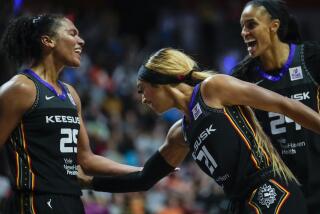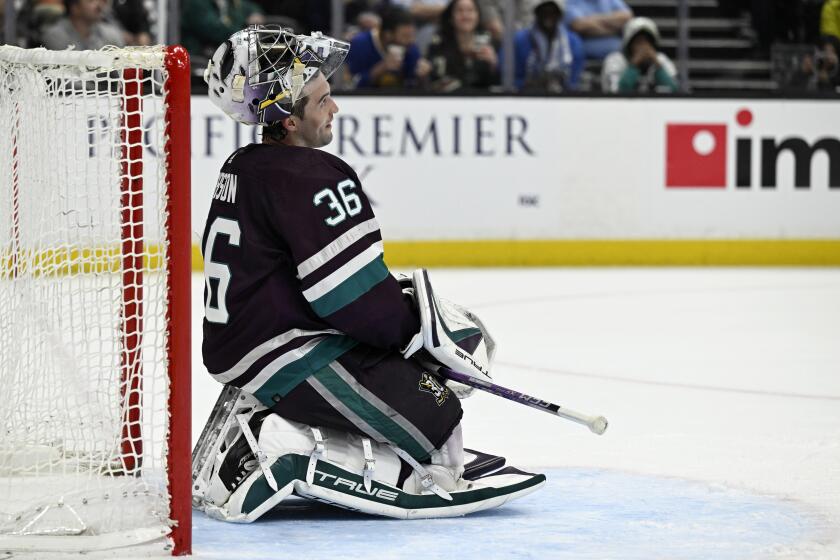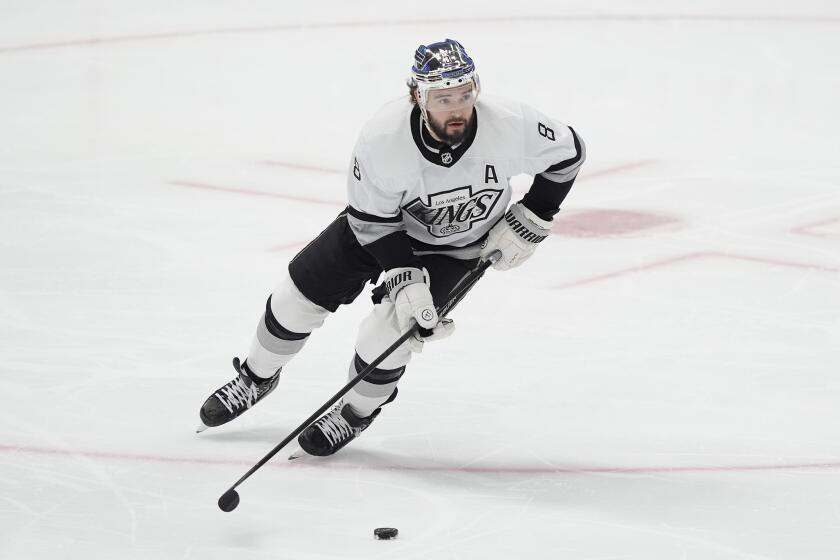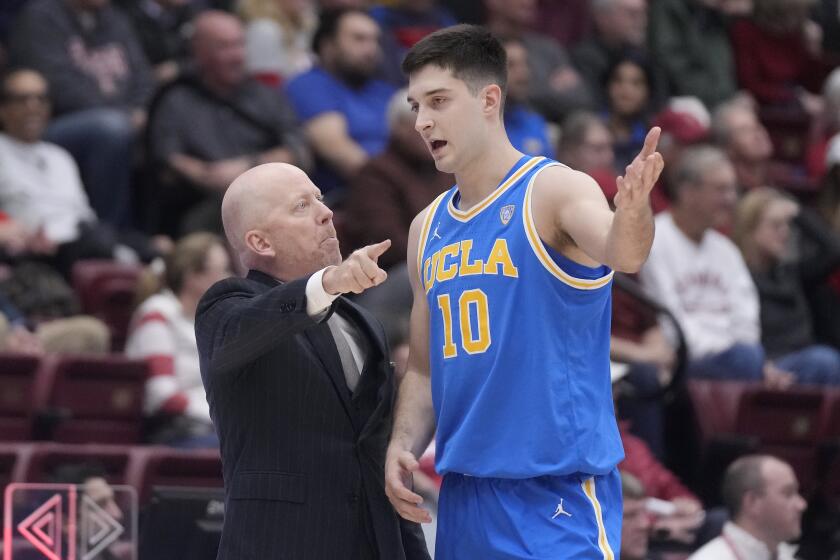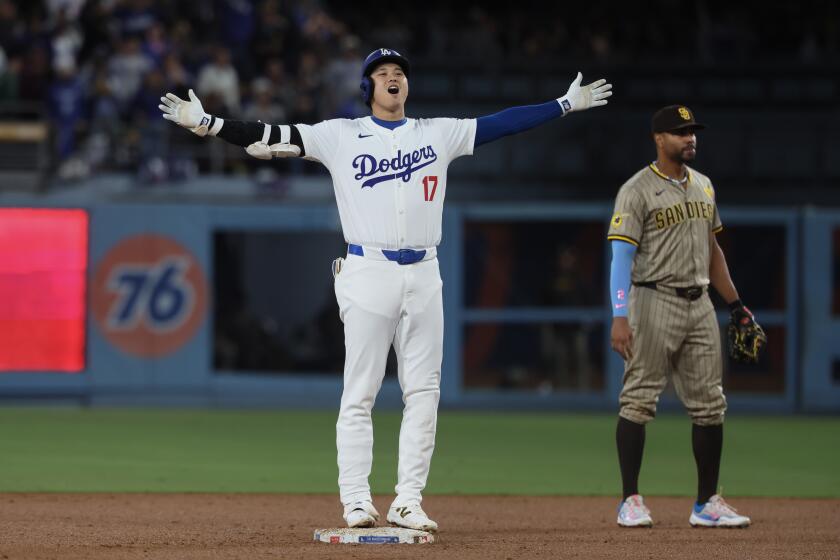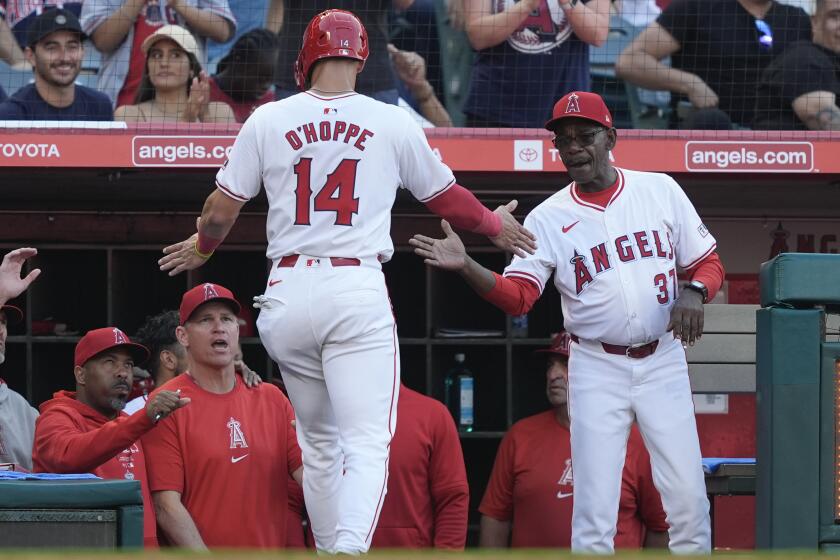Pro Football : Thanks, Raiders, Patriots Needed That Kind of Exhibition Aggravation
Against exhibition-game opponents, the Raiders have managed to play emotional, fired-up football regularly--about once a decade.
Right on time, they did it again last Friday night.
Because the conference champion New England Patriots had annoyed them last year, both off and on the field, the Raiders pounded out a 24-10 win, which is about as hard as they can pound these days.
For the beating, the Patriots seemed sincerely grateful.
“We needed that,” New England lineman Brian Holloway said later. “Everybody wants to beat a Super Bowl team, and when we get into the regular season, everybody is going to be shooting at us. We are fortunate that the Raiders gave us a taste of it.”
The Patriots, who moved the Raiders out of the playoffs last January, 27-20, could be 2-4 or even 1-5 after their first six games, against Indianapolis, Miami, Denver, Seattle and the New York Jets twice. It is a sobering prospect.
“The pressure that the Los Angeles defense can put on you is the best there is,” said Patriot Coach Raymond Berry, whose defending champions had won their first three exhibitions this summer. “It was the right time for our team to play the Raiders, and they were very helpful to us. Tell them that we appreciate it.”
Running back Kelvin Bryant, who served an apprenticeship in the United States Football League, is a strong candidate for stardom in the National Football League.
Although the Washington Redskins are still starting George Rogers in their one-back offense, Bryant, of North Carolina, has impressed all opponents, most recently the Tampa Bay Buccaneers.
Handed the ball only three times at Tampa, Bryant scored on a 22-yard run.
“Kelvin has all the skills you need for (one-back) football,” said Redskin Coach Joe Gibbs.
One of two things seems likely in Washington: Bryant will either replace Rogers or push him into his best season.
The most famous of the Redskins in the years when they were playing in the Super Bowl earlier in the decade were fullback John Riggins and quarterback Joe Theismann.
Some of those studying the new Redskins predict that they will shortly be more effective with Bryant at fullback and Jay Schroeder at quarterback.
Taking a look at the state of the NFL, Commissioner Pete Rozelle recently observed:
--”The average (player) salary in the NFL today approaches $300,000. The contract average is $235,000. Fringe benefits add another $60,000 per player.”
--”(NFL) expansion won’t be possible as long as we’re in court with the USFL. We don’t want them to have a cause of action against us.”
--”Crowds and ratings are up for NFL games, but (TV) sponsors are down. There aren’t as many sponsors as there used to be because of all the (corporate) mergers. When two big firms merge, their total advertising budget isn’t as large as they budgeted separately.”
Most of the highest salaries in the NFL weren’t earned on NFL playing fields.
The league’s average is $295,000 this year partly because many of the big contracts at the top went to athletes who had a big bargaining wedge. Some instances:
--The Buffalo Bills were facing the loss of quarterback Jim Kelly to free agency next year.
--When he came down from Canada, quarterback Warren Moon of the Houston Oilers had his choice of all 28 clubs.
--To get Herschel Walker, the Dallas Cowboys were required to approach the wages that Donald Trump had promised to pay Walker for sitting around this year.
Most of the others in their income class--Bernie Kosar, John Elway, Marc Wilson and Steve Young among them--also had big levers of one kind or another.
Buffalo’s Kelly stands as a classic example of a 1980s millionaire who didn’t earn it against NFL defenses.
Though he was a popular man in the USFL, nobody to this day really knows about Kelly.
He succeeded in a mediocre league, against mediocre defenses, while playing in a passer’s dream system, the run-and-shoot.
That system tends to make journeyman passers look good, and good ones look great, particularly on football’s lower levels.
Kelly, moreover, was injured as a Miami senior, and again in the USFL.
To be sure, he has the size and, seemingly, the range and accuracy of the NFL’s best passers. And he is coming aboard as a refreshing personality.
Reportedly, he began his career with the Bills by criticizing their receivers. “I had better receivers in the USFL,” Kelly told Buffalo writers.
If so, that’s one reason he would have been wise to sit out another season and sign with a stronger club.
It is obvious that he doesn’t have championship talent around him in Buffalo. Whether he’s a champion passer himself is what’s not so obvious.
The Patriots started the season with four veterans named Williams--Derwin, Ed, Jon and Toby, plus Lester, who was waived Tuesday. And one Williams came at a heavy price.
He is wide receiver Derwin, who was drafted in the seventh round in 1984 and who subsequently cost the Patriots another choice, a No. 3, when the NFL penalized them for stashing him on injured reserve.
In the NFL vocabulary, stashing is misusing the injured-reserve list as a place to hide healthy players. Most clubs do this with prospects who would be claimed if waived.
Like a college redshirt, a stashed pro practices with the team and learns the system as the 46th man on a 45-man roster.
The Patriots got caught. And Rozelle may shortly catch some more. He said that the NFL will monitor clubs more closely than ever this season.
“We’ll send a heavier sample of (suspect players) to neutral doctors,” the commissioner said.
The NFL, though, won’t unearth all the guilty. It never has. And in some cases the league will be adding injustice to illegality.
Talking about Patriot Coach Berry, General Manager Patrick Sullivan said: “Raymond had nothing to do with (stashing Williams). He wasn’t here when it happened.”
In fact, all those involved in the Williams decision, including former Coach Ron Meyer, are now out of the organization, the Patriots say.
The NFL response: Fair or unfair, rules are rules.
Who won the race to get the USFL’s best talent?
The Redskins brought in the most candidates.
The Bills, with Kelly, and the Dallas Cowboys, with Walker, signed the best-known candidates.
But the Kansas City Chiefs may have done the best job of solidifying their lineup.
In the 1984 supplemental draft, when NFL teams were earmarking USFL players for future delivery, the Chiefs ignored the bigger names and went for two top linemen, Irv Eatman of UCLA and the USFL’s Stars and Mark Adickes of Baylor and the L.A. Express.
“Linemen last longer,” Les Miller, the Chiefs’ top scout, said this week. “We didn’t know whether quarterbacks like Steve Young and Doug Flutie could make it, but we had spent a long time scouting quality offensive linemen.
“(Eatman and Adickes) figure to outlast the flashier (backs and receivers). Blockers have longer careers than backs.”
The Chiefs are also breaking some new ground this year on the sidelines, so to speak.
They are planning a squad of co-ed cheerleaders.
“We decided to add some zest,” said Donna Scott, the Chiefs’ chief cheerleader.
This puts the Chiefs into men’s lib at a time when the Chicago Bears took a different tack, disbanding their cheerleading squad.
The Bears’ action disappointed, among others, Tex Schramm, president of the Dallas Cowboys.
“Next to our football team, our cheerleaders are the most popular team in Dallas,” Schramm said.
More to Read
Go beyond the scoreboard
Get the latest on L.A.'s teams in the daily Sports Report newsletter.
You may occasionally receive promotional content from the Los Angeles Times.
